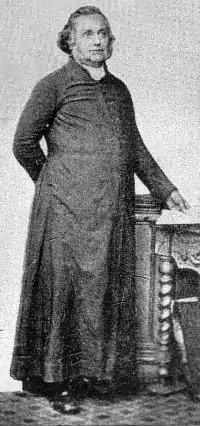Once in Royal David's City
Once in Royal David's City is a Christmas carol originally written as a poem by Cecil Frances Alexander. The carol was first published in 1848 in her hymnbook Hymns for Little Children. A year later, the English organist Henry John Gauntlett discovered the poem and set it to music.[1]
| Once in Royal David's City | |
|---|---|
 Left light of the memorial window dedicated to Cecil F. Alexander in St Columb's Cathedral | |
| Genre | Hymn |
| Written | 1848 |
| Text | Cecil Frances Alexander |
| Based on | Luke 2:4–7 |
| Meter | 8.7.8.7.7.7 |
| Melody | "Irby" by Henry Gauntlett |

Text
Hymns for Little Children was a collection of poems aimed to elucidate parts of the Apostles' Creed for use in Sunday schools or in the home - "Once in Royal David's City" told the story of the Nativity of Jesus to illuminate "Born of the Virgin Mary". Other well-known hymns in the collection included "All Things Bright and Beautiful" ("Maker of Heaven and Earth") and "There is a Green Hill Far Away" ("Was crucified dead and buried").[2]
Alexander was married to the Anglican clergyman William Alexander, who was Archbishop of Armagh, and her most famous poems are commemorated in a memorial window at St Columb's Cathedral, Derry.[1]
Irby
Henry John Gauntlett was organist at a number of London churches, including St Olave's in Tooley Street, Southwark from 1827 to 1846, Christ Church Greyfriars and Union Chapel, Islington from 1852 to 1861. He edited many hymnbooks and wrote over a thousand hymn tunes, although his setting of "Once in Royal David's City" to the tune Irby is his most famous.[3]
Since 1919, the Festival of Nine Lessons and Carols at the King's College Chapel Cambridge has begun its Christmas Eve service, with Dr Arthur Henry Mann's arrangement of "Once in Royal David's City" as the Processional hymn.[1] Mann was organist at King's between 1876 and 1929.[4]
In Mann's arrangement, the first verse is sung by a boy chorister of the Choir of King's Chapel as a solo. The second verse is sung by the choir, and the congregation joins in the third verse. Excluding the first verse, the hymn is accompanied by the organ.
In The English Carol, Erik Routley notes that Mann's unaccompanied arrangement of Gauntlett's original hymn changes the character of the work into one which emphasises the acoustic space of the chapel: "with subtle art that arrangement turns the homely children's hymn into a processional of immense spaciousness."[5]
According to the tradition of the King's College Choir, the soloist of this hymn is usually chosen on the day of the performance, when the choirmaster decides whose voice is the strongest on the day right before the broadcast.[6]
This carol was the first recording that the King's College Choir under Boris Ord made for EMI in 1948.[7]
References
| Wikisource has original text related to this article: |
- Hymns and Carols of Christmas
- Julian, John (1892). Dictionary of Hymnology. London: John Murray. p. 869.
- Crolley, T; Blezzard, J (2004). "Gauntlett, Henry John (1805–1876), organist, organ designer, and composer". Oxford Dictionary of National Biography (online ed.). Oxford University Press. doi:10.1093/ref:odnb/10462. (Subscription or UK public library membership required.)
- Dictionary of Organs and Organists (Second ed.). London: G. A. Mate. 1921.
- Routley, Erik (1959). The English Carol. New York: Oxford University Press. p. 231.
- "What is the Festival of Nine Lessons and Carols – and what is the order of service?". Classic FM. Retrieved 2018-12-27.
- King's College Chapel, Festival of Nine Lessons and Carols Archived 2007-10-16 at the Wayback Machine
External links
- Free typeset sheet music from Cantorion.org